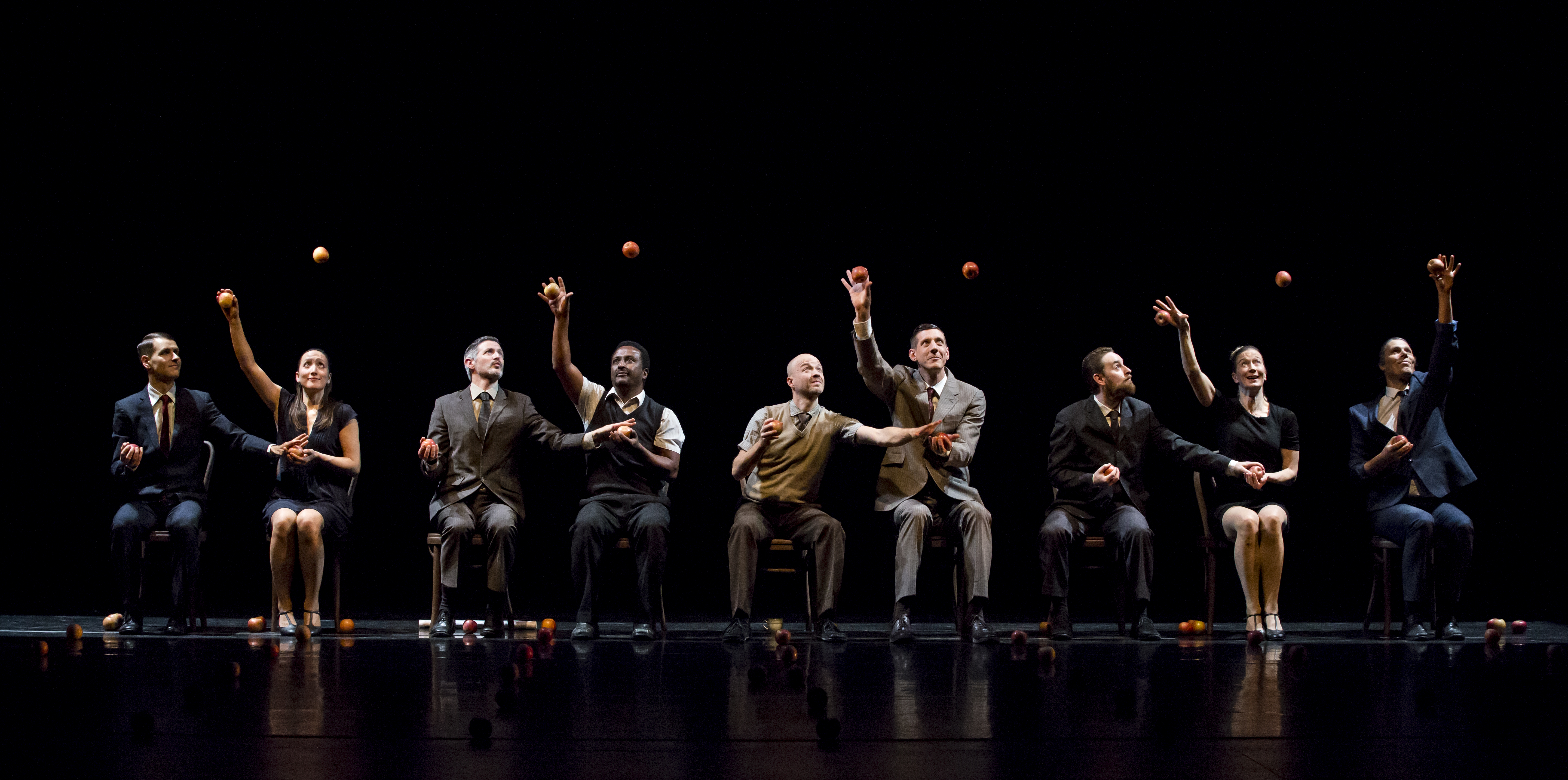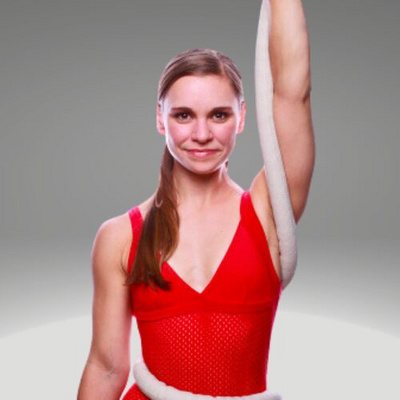Gandini’s Smashed Delivers A Disquieting Minefield of Apples, Tea Sets and Gender Dynamics

I was blown away by Gandini Juggling’s production of Smashed this past Saturday. Apples become grenades and decimate the landscape. Tea sets and china sets explode on impact. A vase of flowers tossed in the air sprays water sideways before shattering to pieces. A man spies an unbroken plate and crushes it underfoot. Almost nothing was left unbroken, particularly the audience’s expectations.
The work premiered in 2010, and despite being almost ten years old, it is still ripe with food for thought. The concept, composition and themes give an audience plenty of pertinent and timely material to chew on post show. And Smashed is just one taste of how Gandini Juggling is satisfying audiences all over the world.
Since its formation in 1992, Gandini Juggling has created 30-full length pieces that have toured world-wide. Acording to the Smashed program, Founders Sean Gandini and Kati Ylä-Hokkala have a mission “to filter juggling through a dance aesthetic.” This spring, seven different touring productions will hit a multitude of countries. If Smashed is any indication of the kind of impact all of their shows have, then Gandini Juggling is fully nourishing the global dance, theater and circus communities.

The production I saw was at Montclair State University. A stranger to the community, the audience seemed to be a mix of members of the campus and the greater New Jersey area. It was a packed house that wasn’t shy to genuinely laugh throughout the production. This made me an outsider in more ways than one, for I rarely found the work funny.
The cast of Smashed is precise, virtuosic and physically eloquent. They are understated yet fully charismatic as they play personas that beautifully teeter on the line between pedestrian and caricature. The ensemble has impeccable musicality over which they lay a dry humor that charms the audience from the first to the final toss. But with the well deserved praises out of the way, let’s get to the meat of the show. Smashed has far more than feats of spectacular juggling to offer it’s audiences. It is often dark and unsettling. Like a tea bag, the longer we sat the darker it got.
A homage to dance theater maker Pina Bausch, Smashed expertly taps into Bausch’s signature aesthetics as well as her commentary on gender and society.
Director Sean Gandini admits, “In a way, I’m relieved people find it dark, because for me, it is a dark piece. I don’t know if it’s an optimistic rendition of the world.”
An open curtain revealed a line of nine chairs set upstage of a multitude of apples placed in meticulous rows. The opening number introduced seven men and two women dressed in grey, navy blue, black, tans and brown business casual garb. They side stepped through the orchard while maintaining a classic three ball — in this case, apple — cascade.
The second piece was quippy and clever. The choreography cutely tinged with gestures of apples over nipples and crotches to the song “I Like Bananas Because They Have No Bones.” These moments were perfect inklings of what was to come; they were a wink to the adult audience in a G-rated film.
Next was a pas de deux that exemplified the intimacy of sharing a physical skill. Torsos pressed together and arms intertwined while apples seamlessly passed hands between the male-female pair. It grew into a display of male posturing and group tableaus that were made orgiastic by a simple hip swivel.
In a way, I’m relieved people find it dark, because for me, it is a dark piece. I don’t know if it’s an optimistic rendition of the world.
The work drew self-conscious truths out of audience. Men attempted to capture women with an exaggerated hug, but when a man captured a man the audience laughed heartily. Why? Because his advances were interrupted by a fellow cavalier? Or because we are trained to laugh at images suggesting homosexuality? It felt like the latter.
The objectification turned blatant as the group of men took turns surrounding each woman, stealing her apples, manipulating her, blinding her and using her body parts to juggle as they wanted her to. Contradictory feelings arose in me: the disgust at the scene’s representation paired with full admiration for the exquisite, complex passing pattern the group maintained without ever missing a beat.
The journey from subtle to overt images of male-female power dynamics climaxed with the two women, apples in their mouths, crawling in front of the seated men. The women are silenced and subjugated. I saw zoomorphism: pigs being sent to the roast. Yet at the end, they stood together in solidarity, apples still in mouths, possibly ready to repeat the scene.
A well placed palette cleanser brought us back to a quirky tea party.

The ghost of Pina returned as the company executed beautiful reel patterns and interweaving circles. Unison juggling with breakaway solos were interspersed with remarkably accurate high tosses and exacting musicality. The company is masterful at sneaking virtuosic juggling skill into compelling group dances.
It was thrilling to watch the full cast maintain a five apple cascade while Sean Gandini disrupted the patterns in a multitude of mischievous ways. For a brief moment, we saw power dynamics that steered away from gender.
This was followed by a scene in which the women completed the third beat of a three apple cascade with a small slap to a man’s wrist, neck, face and buttocks. This might have been a moment where the objectification of the women in earlier scenes was subjugated, but instead, the women always waited for the men to invite them to proceed, and the men might have been enjoying it. In the post show discussion it became evident that to some, it was unclear where the power lay.
Gandini said, “I like the fact that it has ambiguity. I hate political theater that is very black and white, and at the moment it’s very fashionable. Where you go, ‘right on, this is what is right’. As a viewer, this doesn’t give me any choices or dialectics.”
Can an American audience handle such ambiguity? As Gandini said during the talk back after the show, we like firm, bold messages that clearly tell us what stance a production takes. He believes Smashed holds a mirror to life, which is complicated, messy, and often truly ambiguous.
I was grateful when Gandini steered the talk back from gender to race. I was beginning to wonder if the audience had completely missed the moments of violence and stereotype featuring the one black man in the cast. He played the comic relief in way that haunted me with the history of cartoons and caricatures of people of color in the 1800s. He was dismissed, teased and had tea poured on him. His comedic persona and movement vocabulary, which included more dynamic acrobatics than the other cast members, made him seem to exist in a different world than the rest of the cast. I wondered if this was a clear production choice or if this performer brought these attributes to the role and the production blindly absorbed it?
Gandini explained, “The role that Tedros plays used to be played by a white person, and it’s exactly the same. So when Tedros came in, people started saying there’s issues of race in the piece.” Gandini grappled with the new dynamic, “Do I change Tedros to another position because he’s black? Or do I leave him and whatever images they [the audience] conjure…” He continued by impressing upon the audience that these actions on stage are not condoned by him nor the company. He said, “You show an image, it doesn’t mean you agree with the image.”

Gandini sees Smashed as holding a mirror to the complexities and ambiguities of life. I would add that the best kind of live art disquiets each audience member’s biases and asks us to reflect on our aversions and pleasures. Maybe instead of trying to figure out what the show was trying to say, we ask, what do I want to say? Rather than asking what the show was about, maybe we ask, what am I about?
All this in mind, I’m not sure if Gandini would classify the work as overtly political, for he also mentioned, “This show accidentally became this complex minefield. It was intended as homage to Pina.” He went on to say how the very thing he loves about Pina’s work is that it “opens these things” to conversation, and he is happy that Smashed does the same.
But when does a tribute or a homage become appropriation? Let me be crystal clear: I ask this question in no way to project that Smashedhas appropriated Bausch. Smashed is neither a knockoff nor a resurrection of her work. It is a heartfelt and well crafted tribute through a different genre of live performance. It is a prime example of how aesthetics bleed through generations of art makers, and how interdisciplinarity creates important branches on a very non-linear artistic tree.
I ask the previous question in response to an audience member who admittedly didn’t know Bausch’s work and therefore assumed what they saw was solely a Gandini Juggling creation. The company therefore bears the weight of not only the beautiful composition but also the difficult context. How does a company remedy this lack of audience education? Does it need to be remedied? Again, maybe it’s less important what the work shows us and more important to notice what we see in the work.
Smashed takes what seems to be a common circus show trajectory from an orderly beginning to a chaotic ending. The cast abandons the necessary collaboration for pair or group juggling. The comradery has dissolved into undermining each other’s efforts. The cast smashed with a steady level of frustration or ambivalence. I wanted to see the women smash things out of rage for the events that had unfolded, but they were tamer in their destruction.
The piece then comes full circle with a repetition of the cast side stepping through the detritus while maintaining a three apple cascade. Their smiles now warped show us that inside these neat exteriors exists confusion, anxiety, rage and yes, ambiguity. Or to follow my own musings: maybe that’s not what the work is showing me, but what I see in the work.
One thing that lacks all ambiguity, is that Gandini Juggling’s Smashed is an evening of thoughtful and exciting live performance. It is an astounding work that exemplifies the complexities and possibilities of contemporary circus.
All other photos courtesy of Marina Levitskaya/Peak Performances
Editor's Note: At StageLync, an international platform for the performing arts, we celebrate the diversity of our writers' backgrounds. We recognize and support their choice to use either American or British English in their articles, respecting their individual preferences and origins. This policy allows us to embrace a wide range of linguistic expressions, enriching our content and reflecting the global nature of our community.
🎧 Join us on the StageLync Podcast for inspiring stories from the world of performing arts! Tune in to hear from the creative minds who bring magic to life, both onstage and behind the scenes. 🎙️ 👉 Listen now!
